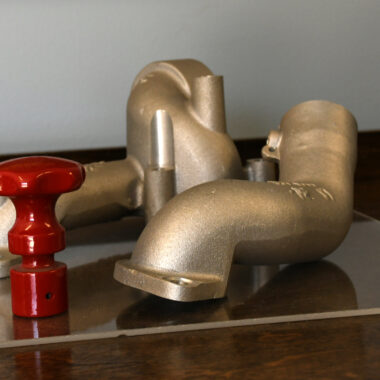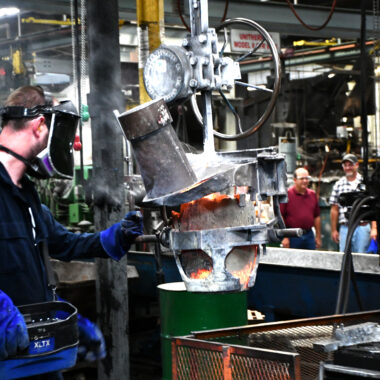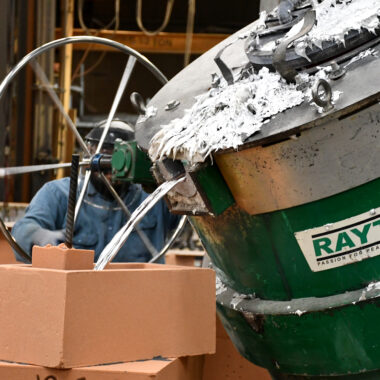Crafting Perfection: Exactly How to Accomplish High-Quality Light Weight Aluminum Castings Each Time
In the world of aluminum casting, the quest of perfection is a constant trip that calls for a meticulous strategy and a keen understanding of the details involved. Accomplishing consistent top quality aluminum castings demands an extensive grasp of the processes, from picking the appropriate alloy to implementing specific mold styles and carefully controlling spreading criteria. However, truth mastery depends on the ability to execute these elements effortlessly to produce remarkable castings every single time. As we check out the ins and outs of crafting excellence in aluminum spreadings, uncovering the essential strategies and methods that lead to impressive outcomes comes to be paramount for those making every effort for excellence in this specific field.
Recognizing Light Weight Aluminum Spreading Processes
Light weight aluminum casting processes, vital in the production sector, involve the detailed makeover of liquified aluminum right into solid forms via a series of thoroughly regulated steps. Understanding these procedures is paramount to attaining high-grade light weight aluminum castings regularly - about aluminum casting. The key methods utilized in aluminum spreading are pass away spreading, sand spreading, and investment casting

Each of these procedures has its benefits and is picked based on variables like intricacy, quantity, and desired surface of the light weight aluminum spreading. about aluminum casting. Understanding the details of these techniques is important for suppliers intending to produce high-grade aluminum spreadings regularly
Picking the Right Light Weight Aluminum Alloy
Choosing the appropriate light weight aluminum alloy is a crucial choice in the production of premium aluminum spreadings. The option of alloy significantly affects the residential properties and attributes of the end product. Various aluminum alloys use differing degrees of stamina, rust resistance, machinability, and thermal conductivity. When choosing a light weight aluminum alloy for casting, it is necessary to consider the particular requirements of the application to make sure ideal efficiency.
One of the most generally utilized aluminum alloys for spreading is A356 - about aluminum casting. For applications needing high strength, 7075 light weight aluminum alloy is a preferred selection due to its outstanding strength-to-weight proportion.
In addition to mechanical homes, considerations such as price, schedule, and post-casting processes must additionally affect the selection of the ideal aluminum alloy. By carefully reviewing these aspects, makers can make certain the manufacturing of top notch light weight aluminum castings that satisfy the preferred specifications.
Executing Appropriate Mold Design
Creating an efficient mold layout is essential for ensuring the effective production of high-grade aluminum castings. Proper mold and mildew design plays a considerable role in attaining the desired features of the final item. To implement a successful mold and mildew design, variables such as material circulation, cooling prices, and part geometry should be thoroughly thought about.
One secret facet of mold style is making sure proper dental filling and solidification of the aluminum within the mold and mildew tooth cavity. This includes designing runner and gating systems that promote smooth metal circulation and avoid defects such as air entrapment or insufficient filling. Additionally, incorporating air conditioning networks right into the mold and mildew design aids control solidification rates and decrease the official statement danger of porosity or shrinking issues.

Controlling Casting Parameters

Ensuring Post-Casting Top Quality Checks
To keep the excellent quality of light weight aluminum spreadings, complete post-casting quality checks are necessary. After the spreading process is finished, it is essential to guarantee that the end products meet the preferred standards and requirements. One of the main high quality checks includes checking the surface area finish of the spreadings to determine any type of flaws such as porosity, splits, or surface abnormalities. This aesthetic evaluation is commonly supplemented by non-destructive testing approaches like ultrasonic screening or color penetrant examination to discover inner defects that may endanger the honesty of the casting.
Dimensional accuracy is an additional important aspect that try here must be verified during post-casting high quality checks. Measurements of crucial measurements and tolerances must be required to confirm that the castings adapt the called for requirements. Additionally, mechanical residential or commercial properties such as hardness, tensile stamina, and impact resistance may need to be reviewed via material screening to ensure that the castings possess the necessary strength and sturdiness for their desired application.
Verdict
In verdict, achieving high-quality aluminum spreadings requires an extensive understanding of the spreading procedures, choosing the appropriate alloy, making molds efficiently, managing casting specifications diligently, and carrying out post-casting top quality checks faithfully. By complying with these steps, my review here manufacturers can regularly create aluminum spreadings that meet the highest requirements of high quality and efficiency.
Achieving constant high-quality light weight aluminum castings demands an extensive grasp of the procedures, from selecting the ideal alloy to implementing precise mold and mildew styles and meticulously managing casting specifications. The main approaches made use of in light weight aluminum casting are die casting, sand casting, and financial investment casting.
Investment casting, additionally recognized as precision casting, entails developing wax patterns that are covered in ceramic to form mold and mildews.Selecting the ideal light weight aluminum alloy is an important choice in the production of high-quality aluminum spreadings.Making sure precise control over spreading criteria is necessary for preserving consistency and top quality in aluminum spreading production.